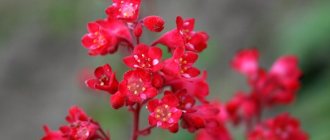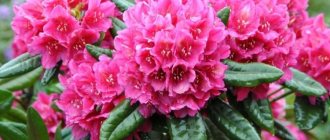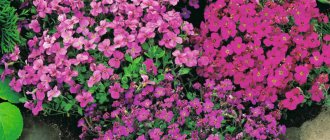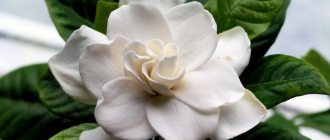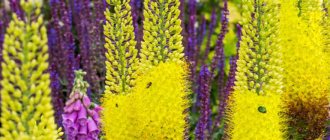Botanical description
Heuchera hairy
Heuchera is a herbaceous plant about half a meter high . There is no central stem as such; the leaves are mostly basal. The length of the petioles can reach 30-40 cm. The leaves consist of five fused lobes, their size is about 5 by 10 cm.
1 The root system of a plant has a rod structure. The central root is quite large and fleshy. Sometimes there may be several roots on one bush; as a rule, this happens when additional roots naturally budding from a larger one. The root length can reach up to 50 cm.
Bushes of various types of heuchera
2 The flowers of the plant are small, mostly inconspicuous. However, some species are quite bright. Their color can vary from white and green to bright red or pink. There are practically no single flowers; they are mainly collected in panicle-type inflorescences.
Heuchera bloody inflorescence
3 The fruits of the plant are capsules containing several thousand seeds. The seeds are extremely small, slightly smaller than a poppy seed. One gram contains up to 20 thousand seeds.
The modern classification of heuchera does not have a single standard. In fact, there are two classifications of the plant: according to one, the genus has 58 species, according to the other - more than 70. The varietal diversity of the plant is quite large.
Over several decades, about 400 varieties and hybrids of the plant were obtained, differing in leaf color and size.
Some Heuchera species are capable of interbreeding with related plants of the same Saxifraga family . An example of such a cross is a hybrid of heuchera and tiarella.
Its distinctive feature is a plant with colorful foliage and fairly large inflorescences.
A variety of colors of heuchera leaves in different varieties
Heuchera is very unpretentious and can grow even on rocky soils completely devoid of soil. There are several species found in the wild, native to the deserts of California and Arizona.
Obsidian, the darkest variety of heuchera
The plant propagates in all possible ways - from vegetative to seed.
The most popular varieties of heuchera
Basically, all modern heuchera varieties are obtained by hybridization of several species forms :
- heuchera americana (showy rosettes with a brown-purple underside and uninteresting inflorescences);
- heuchera hairy with velvety leaves and pubescent peduncles;
- heuchera blood-red (in its homeland its name is “purple bell” because of the pretty tall bell-shaped inflorescences of a bright carmine color; the foliage is carved, very beautiful, dense, wintering well in central Russia).
Thanks to the crossing of these and other original forms, breeders obtained stunning masterpieces with magnificent foliage and inflorescences. The following varieties are definitely worth mentioning .
Silver-leaved - varieties whose foliage has a silvery patina, white and bluish shades, giving the compositions sophistication and sophistication:
- “Mint Frost” is a plant from the group of American hybrids that has greenish foliage with light veins;
- “Stormy Seas” - a heuchera with a beautifully shaped bush, actually reminiscent of a stormy sea, and magnificent lilac-violet leaves with a silvery bloom and dark graphite veins;
- "Can Can" is a miniature variety with very beautiful corrugated brick-colored leaves with silver spots and a beet-colored underside;
- 'Regina' is a showy shrub with silver-gray foliage.
Red-leaved varieties :
- "Purple Palace" ("Purple Castle") - an old, long-known, but still popular variety with large purple leaves;
- “Black Bird” amazes with the dark burgundy, almost black, shades of large leaves and perfectly plays the role of an accent in the composition;
- "Cherry Cola" is a beautiful variety with red-brown foliage and pink lush inflorescences.
Yellow-leaved varieties:
- "Marmelade" is a plant with yellow-orange foliage and a red underside, very cheerful and positive;
- “Key Lime Pie” is the embodiment of lemon freshness in the garden, looks especially impressive in shady flower beds;
- "Citronelle" - a variety with large yellowish leaves perfectly emphasizes the green shades of the garden.
Original spotted:
- "Midnight Rose" is an amazingly beautiful plant with pink specks along a purple field;
- “Color Dream” - it’s difficult to describe the variations in shades of different colors of this beauty throughout the season, a real kaleidoscope of purple-silver-green spots;
- 'Hercules' grows well in full sun, quickly producing lush green leaves with a marbled white 'spray'.
| In addition to the original foliage, heuchera can surprise you with its excellent flowers, suitable for cutting . Florists would highly appreciate varieties such as Heuchera tremulosa Plui de Feu with tall lingonberry-colored inflorescences, Splendens with a huge cloud of red bell-shaped flowers or the Salberregen variety with white inflorescences. |
In conclusion, some more interesting information about heuchera
Landing
Choosing a landing site
This is a very important question because there is no clear answer to it. Adult plants do not tolerate life in sunny areas, preferring shade and partial shade, but this situation is contraindicated for young plants.
The growth rate of young plants in shaded areas is very low and you will have to wait a relatively long time to get beautiful bushes.
Heuchera in a flowerbed
Since the plant tolerates replanting and root separation well, it is recommended to plant the plants in the sun at the beginning of cultivation, and then plant adult plants in shaded areas. Therefore, if you purchase a plant with a developed root system, it sits in the shade.
When planting young or seed propagation of heuchera, planting should be done in a sunny area.
In addition, young animals do not tolerate cold winds well, so the place where they are planted should have protection at least from the north side.
All varieties of heuchera react very negatively to waterlogging of the root system, therefore, growing them in lowlands and any places with high groundwater levels is not recommended.
There is another recommendation for choosing a place for a plant, based on the color of its foliage. Varieties with lightly colored leaves (such as yellow, white or silver) will do well in sunny areas.
While darker ones (green, burgundy, raspberry and blue) grow much better in shading.
Soil for the plant
Heuchera comes from mountainous and rocky areas, where the soil has a predominantly neutral or slightly alkaline environment. Most of the soils of the European continent, if they differ from neutral, are in the direction of oxidation.
Therefore, the soil for heuchera requires liming. Depending on the acidity, liming with ash or dolomite flour can be used.
Dolomite flour is used for liming the soil
The plant does not like too heavy soils; light and well-water- and air-permeable soils are preferable. The plant also requires drainage. It is made from broken brick or large crushed stone; The thickness of the drainage layer must be at least 5 cm.
Planting seedlings
It is most preferable to plant seedlings in mid-spring . Seedlings can be purchased or obtained through vegetative propagation of the plant. In both cases, the measures for planting them are absolutely identical.
Heuchera seedlings
The procedure for planting seedlings is as follows:
1The stems of the plant must be trimmed to young tissue, and shoots that may have dried out should be cut to the level of living brood buds, which are usually located in the axils of the foliage.
2Preparation of the root system involves removing diseased, damaged or fungal-infected areas. Such parts of the root should be completely removed, and the sections should be treated with crushed charcoal.
3Planting is done in squares or in a checkerboard pattern. The distances between plants in a row and between rows are 50-60 cm.
4 A hole with a diameter and depth of 30 cm must be dug under each bush. A drainage system must be placed at its bottom, which is covered with a layer of soil of about 5 cm on top. Next, mineral or organic fertilizers are added to the soil. Nitroammophoska can be used as a mineral (no more than 15 g per plant). Organic matter can be a layer of humus or compost (about 3-4 cm).
5 A young seedling is placed in the center of the hole and covered with soil. The soil is slightly compacted and watered with 3-5 liters of water.
6For the first 2-3 days, it is advisable to shade the plant, after which the protection from direct sunlight is removed.
Planting heuchera seedlings
Complete rooting occurs approximately 40-45 days after planting. It is during this period that the plant can already be transplanted to a permanent place. However, there is no need to rush - it is best to do the transplant at the beginning of the next season.
Planting by seeds
Heuchera seeds
This is not the most common planting method, but with its help you can get a much larger amount of seed material at lower material costs. Growing heuchera through seedlings is quite simple and not burdensome. Moreover, its seeds, subject to storage conditions, have a germination rate close to 90%.
It is believed that the viability of seeds stored outdoors or in a paper bag is six months. The use of sealed packages or foil packages, which prevent access to the seeds not only of moisture, but also of light, extends this period to one and a half years.
After these deadlines, almost all seeds become unusable, so it is recommended to carefully check the dates of seed collection and packaging.
Sowing of seedlings usually occurs in late March or early April. Therefore, you should check whether the expiration dates of purchased seeds correspond to the planting dates.
The seedlings are planted in a box with drainage holes. The height of the box must be at least 5 cm. Any plastic container can be used as a container for growing, even cut off lower parts of large plastic bottles.
The main thing is to make drainage holes in them. It is also allowed to grow plants using peat tablets with a diameter of 27 or 36 mm.
Seedlings after germination
Seedlings require loose soil. Its composition is not of fundamental importance. It can even be ordinary garden soil, or a mixture consisting of equal proportions of peat, garden soil and sand.
If regular soil is used, it is recommended to mix it with a small amount of sand or perlite to improve its air and moisture permeability. The volume of sand or perlite is taken from 1/5 to 1/3 of the total volume of the soil mixture.
The soil must be thermally treated in order to kill the fungi in it. To do this, you should either pour boiling water over it, or place it in the oven for half an hour at a temperature of +110°C. After that, the soil must be dried for 24 hours and only then can you start planting the seeds.
Heuchera seeds are very small; sometimes it is recommended to mix them with sand when planting. The small size of the seeds does not mean they are buried in the ground. Therefore, after preliminary preparation of the soil, you should level its surface and moisten the top layer with a spray bottle.
Sowing is carried out directly on the soil surface. After which the box with seeds should be covered with glass or film.
Seeds require a large amount of light to germinate, so it is recommended to immediately place the box with them on the windowsill of a south-facing window. In this case, it is necessary that the temperature in this place be around + 18-20 ° C and there are no drafts.
Every day the box with seeds should be ventilated by removing the film or glass for 15 minutes. Watering should not be done daily, but as the soil dries. In about 15-20 days the seeds will sprout.
The film or glass should not be removed. They need to be raised a little; in some cases, several small holes are made in the film.
Picking seedlings is done when three true leaves appear on it . Seedlings are planted at distances of 4 to 6 cm between them. During this time, the soil should be kept moderately moist.
Seedlings picked into separate containers
Next, there are two options for further growing seedlings. Continue growing plants indoors or transplant them into open ground in a sunny area. Each of them has its own advantages and disadvantages.
Since a normal rosette is formed in heuchera within about one year, it is best to continue growing indoors. In this case, around June-July, the seedlings should be transplanted into larger boxes.
In the summer they can be taken out into the open air, or even remain there continuously until the end of the season, but with the onset of cold weather they are again placed indoors. The final planting of seedlings in open ground takes place in the spring of next year. This growing method is applicable in areas with harsh winters.
If cultivation takes place in milder conditions, it is possible to plant the plants in a sunny area in the garden already in mid-summer, corresponding to the year of planting. In this case, the plants will be better adapted for further cultivation.
However, in this case they will need to be covered for the winter with a layer of mulch about 10 cm thick. Peat, sawdust or compost should be used as mulch material.
Plant care
Mulched heuchera bushes
Directly maintaining heuchera in a healthy form does not require practically any action from the owner, since the flower, accustomed to growing in desert conditions, tolerates both summer and winter of temperate climates.
Watering should be seriously limited, since in fact even the level of natural precipitation in a temperate climate is excessive for heuchera.
To maintain the required level of moisture in the soil for a long time, it is recommended to mulch the soil around the plant with sawdust or pine needles in a layer of 3 to 5 cm. For mulched plants located in the shade, the amount of natural precipitation will be quite sufficient. Watering should only be done if the soil dries out excessively.
Plants located in open sunny areas should be watered at an average frequency of 1-2 times a week. To maintain soil moisture, mulching of such plants is mandatory.
Even poor soils for mature plants have a sufficient level of fertility. However, you should not completely ignore fertilizing: once a year, at the end of the season, it is recommended to mulch the plants after autumn pruning with a layer of peat or a mixture of peat and humus in a ratio of 1 to 1.
The above applies to decorative deciduous varieties of heuchera. There are also several dozen decorative flowering varieties. They require fertilizing with complex flower fertilizers before and after the flowering period.
Of all the procedures for caring for a plant, the procedures of pruning and loosening the soil remain the most relevant. The need for pruning in temperate climates increases significantly, since the abundant growth rate causes rapid growth of leaves. This leads to a strong thickening of the bushes and the plant simply becomes crowded.
Watering the plant before loosening
Typically pruning is done at the beginning and end of the season. The plant is actually evergreen and many of the leaves that appear in the second half of summer can easily survive the winter.
Pruning at the end of the season consists of removing diseased and damaged parts of the plant , as well as trimming excess side shoots and petioles that have lost leaves. But even old leaves are not removed during autumn pruning.
Removal of too old, as well as diseased and injured leaves is done in early spring. Also at this time, formative and stimulating pruning of the bush is performed.
Loosening the soil is important because the plant's root system needs a lot of air. The rocky soils of the plant’s homeland allow this process to proceed without problems, but in the heavy soils of the temperate zone the plant may have certain problems.
Typically, loosening is done once every 2-3 weeks. In this case, the soil in the area with heucheras is watered with a very small amount of water (to wet only a 2-3 cm layer at the surface) and loosened to the same depth.
Simultaneously with loosening, it is imperative to carry out the procedure of hilling the bushes, since the core of the bush is constantly sticking out of the ground. However, you shouldn’t be too zealous about this either.
The main thing in hilling is to cover the sockets to prevent them from drying out or frostbite.
Color harmony in landscape design
If heuchera was once in the role of Cinderella in the flowerbed, today it is leading the list of candidates for decorating the flower area. The varieties bred by breeders never cease to amaze lovers of gardening creativity. Therefore, the magnificent plant, heuchera, has taken its place of honor in landscape design.
It can be seen in various green compositions:
- flower and shrub mixborders;
- in the company of proud roses, irises, ferns and lilies;
- in combination with tulips, crocuses and daffodils, geraniums and hostas;
- when forming rock gardens;
- for decorating borders;
- in container versions on the garden plot (gazebos, terraces);
- for the design of coastal zones of artificial reservoirs.
The bright leaves of heuchera serve as an indispensable accent to the green garden throughout the season. They are used for a harmonious transition from plant to plant. Thus, the emptiness of the site is completely filled during the flower off-season.
Heuchera does not require special care. Does well in sun and shady places. Frost-resistant. Easily propagated. Not sick.
In the photo shown, the heuchera looks wonderful in the company of its relatives. The variety of shades of its leaves allows you to create a motley multi-colored corner on the site.
Many gardeners have noted that working with heuchera is a pleasure. It blends harmoniously with any plants in the garden and always looks royal.
Plant propagation
There are three main methods of propagation of heuchera : two of them are vegetative - by dividing the bush and cuttings, and one is by seed. The latter was discussed in detail earlier in the landing section. Now let's turn our attention to the vegetative propagation of heuchera.
Dividing the bush
Excessively thickened heuchera bush
By dividing the bush Once every 3-4 years, the plant must be replanted to avoid excessive thickening of its root system and leaf rosettes. Typically, the operation to divide the bush is carried out either in early May or in mid-August. For this purpose, the bush should be dug out of the ground without damaging its root system, and its structure should be carefully examined.
It should be said right away that you should not leave large groups of rosettes, since the bush will have to be replanted next year . It is necessary to properly divide the bush, leaving 2-3 leafy rosettes in each plot.
The division should occur in such a way that the rosettes falling into each plot are located on the same rhizome. When dividing, use a knife or pruning shears disinfected in alcohol, and sprinkle the cut areas with crushed charcoal powder or cinnamon.
Also, during the division of the bush, its root system is sanitized - excessively long, dry and damaged roots are removed from it.
Further work with seedlings was described earlier. We just have to remind you again that in the first year of independent life, it is best to plant a seedling not in a permanent place, but in a special bed for young animals, located in a sunny area. Thus, the plant can quickly form new rosettes and leaves in just one season.
Cuttings
Heuchera root cuttings
Cuttings This method is simpler and not as radical as dividing a bush. It can be applied to plants of almost any age. The essence of this method is that only a rosette with a small part of the root is cut off from the mother bush, after which it takes root in ordinary soil into which young seedlings are planted.
To ensure the guaranteed appearance of roots in such a cutting, it can be placed in a nutritious sand-peat substrate . As a last resort, you can place the cuttings in ordinary water, diluted with rooting agents and stimulants like Epin.
Usually, the roots of the cuttings appear after 3-4 weeks . After which they are transplanted to a sunny area. Plants that were immediately planted in the ground should be protected during rooting with improvised greenhouses made from plastic bottles.
Heuchera from seeds at home Growing seedlings
Heuchera growing from seeds at home Photos of seedlings
When to plant heuchera seeds? Seedlings are planted in March or April. It is not difficult to sow heuchera for seedlings; the rules of care do not differ at all from the usual agricultural techniques for growing small-seeded plants:
- We use a light substrate for planting, or you can use ready-made soil mixture for flowers from the store.
- We only use containers with holes in the bottom for good drainage.
- You need to sow carefully so as not to thicken the seedlings. You can place the seeds on a folded piece of paper and help yourself with a toothpick. So you can easily place the seeds at a distance of 2-3 cm from each other.
- Afterwards, the seeds are covered with a thin layer of earth or sand, gently moistened (with a spray bottle), and covered with glass, transparent plastic or polyethylene.
- Ventilate once a day, and after germination the cover is removed.
- Watering is carried out moderately so as not to provoke the development of putrefactive diseases.
- When the third leaf appears, the seedlings are transferred into separate containers for further growing.
- Two weeks before planting in the ground, hardening is carried out, gradually accustoming the plants to fresh air and sun.
Heuchera flower planting and care photo seedlings
To plant in the ground , the seedlings are carefully removed from the cup and placed vertically in the prepared hole, while simultaneously filling the remaining space with soil. Water abundantly to completely moisten the earthen clod.
Characteristic
If you do not plan to collect seeds, you can cut the flowers.
It is not difficult to grow heuchera on your own plot, but it has several features that a gardener who decides to grow this perennial species should know:
— If you grow decorative and deciduous varieties of heuchera, then you need to cut off the flower stalks that appear in the bushes; they tower above the plants and look extremely disorderly. Peduncles are left only if the seeds are going to be collected in the fall.
— In decorative flowering varieties, the flower stems are cut off immediately after flowering. The lower foliage flies off over time, which negatively affects the decoration of the plant.
And a note! Before the bush begins to bloom, it is taken out of the ground and planted in a new, deeper hole with clods of earth, thanks to this it will be possible to hide the bald trunk.
- Young foliage begins to grow in rich, translucent colors (similar to flower petals), but becomes darker and denser over time.
— Heuchera bushes go well with daylilies, primroses, astilbe and ornamental grasses.
Watering and fertilizing
An elegant representative of the saxifrage family can successfully develop in dry and moist soils. The plant easily tolerates short droughts. Heuchera is irrigated with small doses no more than once a week. The agrotechnical procedure is carried out using a garden watering can. It is important to prevent stagnation of liquid and waterlogging of the soil. Water is supplied under the bush, avoiding contact with the leaves.
The preferred watering time is early morning or late evening, when there is no solar activity. In hot weather, additional watering is organized as necessary if the soil in the root zone is very dry.
Mineral mixtures are used to feed decorative crops. Excessive saturation of the soil with nutrients provokes heuchera diseases. When using fertilizers, it is recommended to reduce the volumes recommended by the manufacturer by 2 times. In the 2nd year of cultivation, universal complex formulations are added. The nutrient mixture is applied before and after flowering in moderate quantities.
Suitable:
- "Nutrisol". The mixture is saturated with mineral compounds, enriched with manganese and iron. “Nutrisol” is produced in the form of a powder intended for dilution in irrigation liquid and application to the root zone of the bush. The composition is easily dosed, prolongs the flowering period of heuchera, and improves the decorative properties of the crop.
- "Fertika". The nutritional composition is used for root feeding of flowering plants and spraying before the start of the growing season. The drug is saturated with sulfur, potassium, copper, boron, molybdenum. Fertik does not contain chlorine components that stimulate excessive thickening of the bush.
- "Agricola". Increases the intensity of budding by 20-25%. The drug supplies ornamental crops with vitamin compounds and mineral components. Agricola contains manganese, boron, and zinc. The nutrient mixture is suitable for soils of any type and acidity level. Release forms: liquid concentrate and fine-crystalline powder.
- "Humisol". An effective biological growth stimulator, which is recommended for feeding seedlings. Improves flowering and prolongs the growing season. Protects the crop from fungal infections and rotting of the root system during heavy rains.
The plant extracts most of its nutrients from the soil. Heuchera does not need frequent feeding. It is undesirable to introduce a significant amount of natural organic matter into the soil. Such substances cause rotting of the root system.
Soil preparation
To preserve the decorative properties of the plant, choose a sunny area with the possibility of light shading during the midday hours. Heuchera is undemanding to the composition and acidity of the soil, but develops better on soils with a neutral pH value.
When preparing the site, it is important to take care of drainage and aeration of the soil. A mixture of fine sand and peat material is added to clay soil. Approximately 14 days before the planting date, the site is dug up to give the soil a loose structure and remove weeds.
To regulate soil acidity, liming is used or green manure is planted, which inhibits the development of harmful plants, improves the chemical composition of the soil, and fills it with:
- nitrogenous substances;
- protein compounds;
- starch;
- carbohydrates;
- microelements.
The soil is pre-fertilized with compost. For preliminary greening of the site, legumes, cereals, and amaranth are used.
The procedure improves the development of heuchera by:
- Increasing the percentage of organic matter in the soil. Green manures of the legume family, which include peas, vetch, and annual lupine, bind nitrogen atoms extracted from the atmospheric mixture and convert them into a form suitable for consumption by heuchera.
- Additional soil aeration. The root system of green manure penetrates deeply into the soil layers, lifting nutrients to the top.
- Acceleration of humus formation.
- Increased microbial activity. As a result, mycelium useful for decorative culture is formed.
- Attracting pollinating insects.
To improve the structure of the soil cover in flower beds and lawns, dolomite flour or wood ash is used. The substances simultaneously regulate the acid balance of the area.




